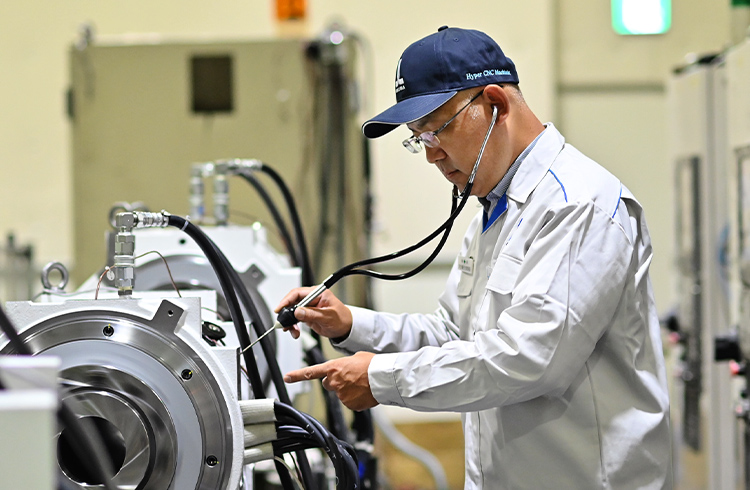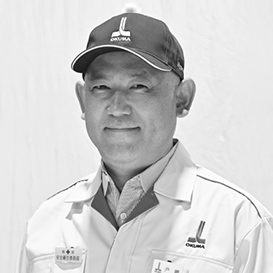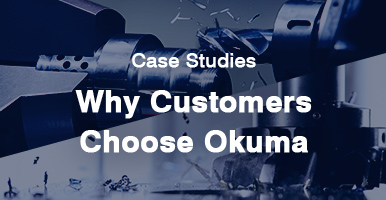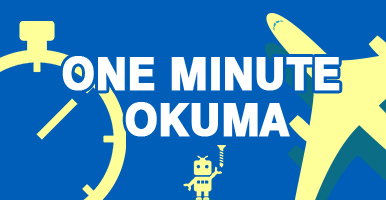Main unitQuantify and precisely control
all accuracies

With numbers in micrometer units flying about,
inaudible vibration is measured
The heart of a machine tool is the main unit, including the headstock, turret, and tailstock. At assembly sites, you'll hear numbers like 1, 3, and 5 flying about. These are numeric values such as parts accuracies, assembly accuracies, or tightening margins for fitting work in which parts are fit together, with the units all in micrometers (1 μm = 1/1000 mm). Here, this is standard.
Takashi Tozaki, a leading expert on unit assembly for lathes and multitasking machines, says, "Even if parts are machined as designed, errors of several micrometers develop during the assembly stage. Making fine adjustments for these errors and delivering the specified performance is our job in the unit assembly process. For this reason, we frequently use measuring instruments in machine shops and complete the process while constantly checking these numerical values. The highest assembly accuracy is pursued for every machine, with the same rigor for both high-end and popular models."
For vibration, an indicator of the stability of spindle rotation, a sensor is mounted to the spindle support body to carefully measure frequencies that are inaudible to the human ear. If an abnormal frequency is detected, the source (the balls, rollers, raceway, or other components inside a bearing) is identified and addressed.
In the past, expert engineers used to listen to the sound of spindle rotation and judge whether it was acceptable. This technique is still used today, and a stethoscope is sometimes applied to a machine to diagnose the sound of rotation. In this way, quality is built in at Okuma through a fusion of the latest measuring instruments and skills based on fine honing of the five senses.
Demonstrating outstanding skills also in overseas customer support
Many of the skilled workers who have gained a certain amount of experience in Japan hope to be assigned to Okuma's overseas locations and are sent on the recommendation of their superiors.
Mr. Tozaki, who later became a master, was one of these people. He had extensive experience in main unit assembly and maintenance, so he was assigned to Okuma Europe GmbH (Germany) from 1988 to 2005. His main task was to provide guidance the service staff of local distributors about accuracy adjustments for multitasking machines, spindle assembly, and maintenance skills.
Okuma Europe GmbH covered a vast area, including Europe, parts of Africa, and countries in the Middle East, and when the cause of machine malfunction was unknown or an emergency repair required advanced technology, Mr. Tozaki needed to visit the customer's factory to handle the situation.
Mr. Tozaki responded to a variety of emergencies, but the events at a marine engine manufacturer were unforgettable. At that time, a large 5-axis machine delivered several years previously was malfunctioning, and the machine shop was experiencing a great deal of difficulty. Mr. Tozaki rushed to the site and inspected the machine over the course of several days, but he could not determine the cause. However, he noticed that one part on the tool changer was different from what he was used to seeing, and when he tested the machine after loosening a mounting bolt on that part, there were absolutely no machining defects.
When Mr. Tozaki asked about the source of the part, the customer said, "A few weeks ago, an internal problem caused a tool to come off and the fitting to deform, so we manufactured a replacement in-house." A detailed investigation revealed that the part assembly and alignment work was inadequate and that the cause of the malfunction was the inability to realize the machine's proper cutting capacity. The factory manager was so impressed by Mr. Tozaki's observation abilities that he personally drove him to the airport.
His policy is "determine the cause and always make repairs," and this episode shows his great determination and sense of mission.
Tradition and corporate culture that foster craftsmanship
Outstanding technology and skills cannot be acquired overnight. At Okuma, the corporate culture of aiming for the highest level of technology and skills has permeated every corner of every division,
creating the foundation for the pursuit of innovative product development and high quality.
In particular, the OKUMA Technology and Skill Tournament, held annually since 1964, makes it possible for employees to demonstrate their daily efforts and confirm the transmission of techniques and skills.
Within this culture, more than 1,000 certified skilled workers have passed National Trade Skill Testing & Certification, 19 of which are masters certified as Master Craftsman and 8 of which are top-class masters certified as Contemporary Master Craftsman by the national government (as of September 2022).
Visualizing know-how and passing on skills in the Monozukuri Dojo
Okuma focuses on not just training skilled workers. We are working to maximize the value of our skills by turning the know-how inherited by masters from more senior staff or devised by them into digital data (documents, drawings, and manuals) and sharing it with every department, applying it to improve product functions, and using it for process improvement.
Furthermore, in the Monozukuri Dojo, which was established in-house in 2007, employees are grouped by year of employment and skill level and undergo "training to master the use of tools," from the acquisition of basic manufacturing techniques to advanced skills specialized in machining and assembly, under the guidance of masters.
Okuma's goal is to "train multi-skilled workers" with a wide range of knowledge and skills not only in specialized fields but also in peripheral devices and CNC control fields.
Talented personnel who can respond to the all-round needs of Okuma, which develops and manufactures a wide variety of machine tools in-house as well as NC equipment and automation systems. They are also a driving force behind the trust of the OKUMA brand.
Master Craftsman of Okuma
Metalworking machine-tool assembler
TAKASHI TOZAKI
- 1991
- Joined Okuma Corporation
- 1998 — 2005
- Assigned to Okuma Europe GmbH (Germany)
- 2017
- Selected as a Master Craftsman in Aichi
- 2017 —
- Aichi Prefecture Trade Skill Testing & Certification, Trade Skill Test Commissioner



![01 [Machining] CNC Lathe/Multitasking Machine — Uncompromising craftsmanship in the manufacturing of spindles](assets/images/case/bnr_case01_on.jpg)
![01 [Machining] CNC Lathe/Multitasking Machine — Uncompromising craftsmanship in the manufacturing of spindles](assets/images/case/bnr_case01.jpg)
![03 [Machining] Machining Center — Machines are alive: hone your five senses to respond to their changes](assets/images/case/bnr_case03_on.jpg)
![03 [Machining] Machining Center — Machines are alive: hone your five senses to respond to their changes](assets/images/case/bnr_case03.jpg)



